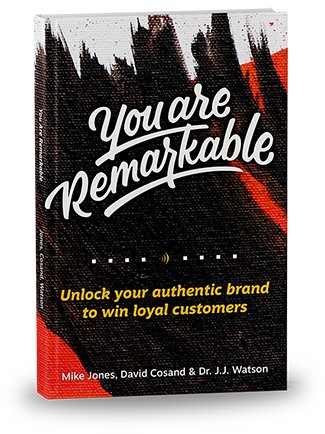“Let’s go grab dinner!”
“Yeah!” “Awesome!” “Sure!”
“Where do you guys want to go?”
“I’m thinking Italian.”
“NOOOOO…not Italian! How about Mexican?”
“I had that for lunch.”
Has anyone else been a part of this group? The kind of group cannot come to a consensus to save their lives because there’s no foundation? The kind that makes you want to pull your hair out after hours of discussion? Yeah, you know what we mean.
This situation is all too common when people don’t understand their own brand. Specifically, when there’s no brand foundation.
Say a company decides to build a shiny new website. A meeting is scheduled, and everybody who happened to get invited (or coerced begrudgingly) sits down to figure out what they want. Everyone tosses in their pet peeves about the current site and lobbies for the one pet function that they absolutely insist the site absolutely must have, absolutely, because they saw some other company that had it. (Although they’re in an entirely other business). Then they try to talk about design — and the most anyone can do is throw out random observations and preferences: our competitors all do this, so we should too… this look I saw a few years ago seems cool and fresh … we’ve always used this font, we can’t change it now … I’m so tired of our logo from 1972 … using Papyrus makes it feel exotic! … but blue is my favorite color!
Because there’s no basis for the design, they’ll end up with a hodge-podge assortment of ingredients that don’t make sense to the company and aren’t consistent with each other. Two years later, the same group of people (plus maybe a new intern) will meet to completely redo the website that’s still not working. There’s no rhyme or reason.
Thankfully, there is a way for you to create rhyme and reason. If you’ve already “found your frequency,” and developed your brand, you now have a foundation that you can build on to make decision-making easier and more sensible. Here’s how Resound turns your values and personality traits into concrete design concepts that you can implement.
Brand Metaphor
You might be asking, “What does a metaphor have to do with branding?” Brand metaphors are core concepts that should inspire the overall experience of a company, including the visuals, messaging, and customer interactions. Just like you would link words and ideas in order to better convey meaning, a brand identity should be linked with familiar concepts to better convey the feelings and emotions of the brand to it’s audience. In using an already familiar idea or story as the basis for the brand experience, you can help your fans interact with the brand in a way that more easily resonates.
In other words, the “vibe” people get from a brand’s visual and verbal presentation should match up with the “vibe” they associate with its metaphor.
For instance, our office supply company might have the moon as their brand metaphor. Most people associate the moon with beauty, power, consistency, mystery, and light. These are the same associations that customers should make when they interact with our company. So we might use the brand metaphor by incorporating visual ingredients such as grays and navy blues into their website and materials. Their verbal guidelines might mean writing in short, elegant sentences.
Note: A brand metaphor is not a theme party. Even if your brand metaphor is “the Apollo 12 mission”, you’re not going to incorporate moon rocks and space shuttles into your store decor. You’re not re-creating the surface of the moon. You’re not naming your business “Moon” and your website error pages does not say “We Apollo-gize.”
The implementation will present itself in the tone and texture of your design and conversation. Your customers won’t even necessarily “see” the theme, and shouldn’t be able to guess what it is, but they will “feel” it.
Your brand metaphor will help you create many things. Here are a few of them:
Visual Guidelines
Humans are very visual. Patterns, colors, and fonts will help people understand and remember you.
These design aspects should be consistent with who you are as a company and should be fueled by your brand metaphor. If you’re a hip, upbeat, frozen yogurt company, you probably shouldn’t use dark or subdued colors (unless you’re going for the Hot Topic crowd). The shapes in your text and materials should have movement and flow, instead of being boxy and solid.
Miss: Hit:
Pick four or five colors that will feature prominently in your brand, and pick one or two fonts for all your web content and documents. Include textures or patterns that personify your brand as well. This way, people begin to recognize your communications. They’ll open your email and automatically know, because of the design ingredients, that it’s from your business.
Verbal Guidelines
It’s not what you say, but how you say it
Imagine a company that prides themselves on being friendly. They are the folks who will answer a call and talk with clients for 15 minutes just to build relationship. They remember names, product preferences, and suggestions. Now imagine that you go to their website, and it sounds like it was written by a lawyer. Would you ever guess that they were open, friendly, and relationship-centered? No way.
A good verbal guideline for this company would be to write conversationally – the way normal people speak.
Miss: Any comments or questions should be directed to our Contact Us page.
Hit: Do you have a suggestion? We’re always looking to make things better!
When you nail down and define how your company writes, you can give those guidelines to any employee or contractor. They’ll write like your company, even if they haven’t known you very long.
Logo
This is the visual representation of your company. Ideally, people look at your logo and recognize your company. Look at these pictures:
You probably weren’t thinking “Oh! It’s an M! A seashell! An apple! and a green-nymph-thing….what is that even?” You were probably naming off brands. McDonalds. Shell. Apple. Starbucks. How did you know that? Because each of these companies has done a great job of incorporating their logo into the overall customer experience with consistency.
You don’t want a mix-and-match logo that incorporates a little bit of everything and communicates nothing. Or a logo that reflects a previous state of your company, and is no longer relevant. The question to ask is this: Does this logo express the brand the way I’ve defined it? Is it consistent with my values and personality?
If you can’t explain your logo, it’s time to change it.
Build Your Foundation
You don’t want your company to move in a new direction with every design opinion that comes along. The visuals should work with the logo, which work with your writing style to create the unified personality that is the face of your company.
Strong guidelines helps anyone and everyone create images or text that consistently communicate your brand. Whether it’s someone in house, a contractor, or an outside agency, there will be consistency: everything will give off the same vibe that people recognize as coming from your company.
Want to learn more about consistency in branding? Sign up for our email list.



